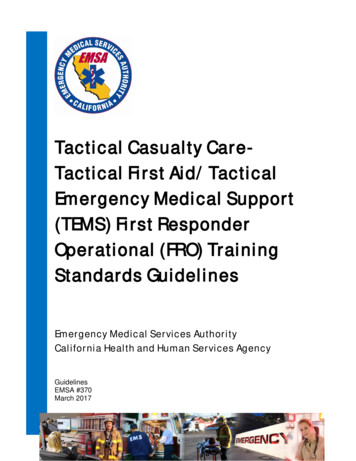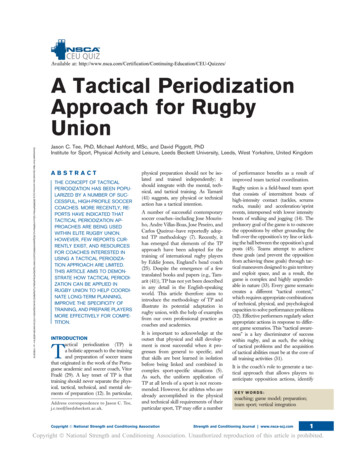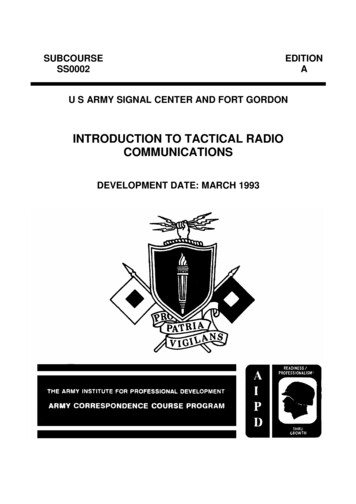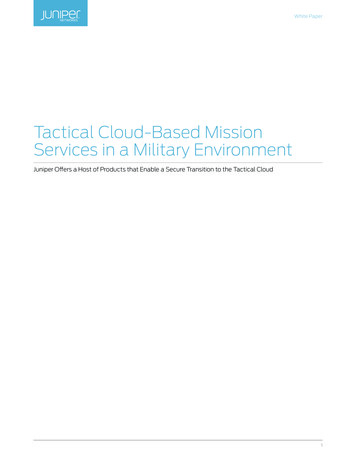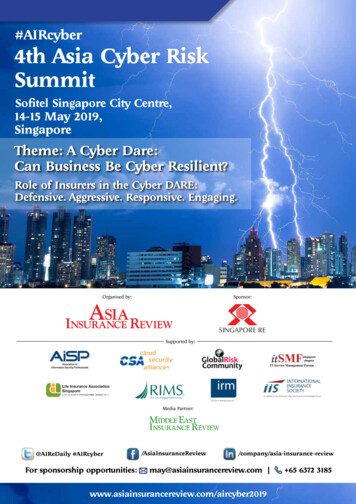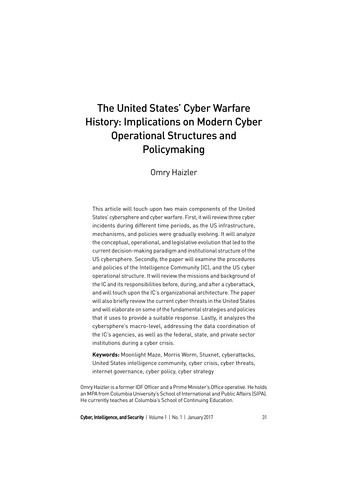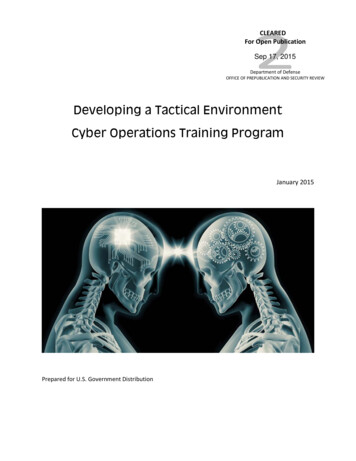
Transcription
CLEAREDFor Open PublicationSep 17, 2015Department of DefenseOFFICE OF PREPUBLICATION AND SECURITY REVIEWDeveloping a Tactical EnvironmentCyber Operations Training ProgramJanuary 2015Prepared for U.S. Government Distribution
FX3RD-35014Disclaimer: Our conclusions are based exclusively on unclassified, open source information derived from Fox Three observations. None of the information in this report involves access to or confirmation by classified intelligence.ii
FX3RD-35014McKeller Corporation was tasked by the Office of the Under Secretary ofDefense for Personnel and Readiness to identify gaps between training requirements and current existing capabilities for tactical environment cyberoperations (TECO). The study is intended to provide a training strategyand investment roadmap for the Department of Defense to support TECOobjectives. This document provides actionable information for developingTECO training curriculum and the associated environment for training delivery and execution. The study was conducted by McKeller Corporation inconjunction with Fox Three Research LLC, primarily at Fox Three’s officesin McKinney, Texas.iii
FX3RD-35014Executive SummaryThere is a growing realization that the military must prepare for operationsthat blend cyber and traditional capabilities at the tactical level. Indeed,various entities at DoD, Joint, and Service Component levels have expressedan interest in the tactical integration of cyber capabilities.Traditional cyber operations focus primarily on information and communications technology (ICT) at the operational and strategic levels of war.From a tactical perspective, the integration of cyber capabilities with traditional force employment is not well developed. The intent of this study isto set the stage for the development of a pilot training program that blendsvarious areas of cyberspace and tactical operations into a new skill-set. Inthe context of doctrinal terminology, this skill-set is yet to be defined andwill be referred to under this study as Tactical Environment Cyber Operations (TECO). This study introduces the TECO concept, identifies shortfallsin current training efforts, and provides a way-ahead for developing a pilottraining program to meet DoD TECO requirements.The TECO concept is different from the traditional employment of cybercapabilities. TECO focuses on the integration of cyber capabilities in relation to other tactical military capabilities for creating coordinated battlefieldeffects. The TECO environment necessitates a rigorous and tailored training program. As military forces begin to integrate cyber capabilities into thetactical environment, the attacks will no doubt face the same scrutiny andconcerns as traditional kinetic weapons; perhaps even more so. The TECOtraining program must incorporate military principles of warfare and missionsets with the understanding that tactical cyber initiated actions may equateto lethal force.Findings from this study indicate that available training is not adequatefor developing the necessary skill sets required for the TECO environment.The primary gap is the need for a robust training facility that incorporatesreal-world critical infrastructure. The training facility must enable hands-ontraining, integration with other tactical forces, and evaluation of mission operations across the range of TECO core activities. The study also identifieda significant shortfall in adequate supervisory control and data acquisition(SCADA) training for military personnel. Current training focuses primar-iv
FX3RD-35014ily on defending and exploiting traditional ICT systems and does not sufficiently incorporate the physical components and processes associated withSCADA systems. Military cyber professionals need a training facility thatconsists of real-world SCADA to gain an in depth understanding of the effects that cyber initiated actions have on the physical processes.As part of the analysis for this report, a site survey was performed at theAtterbury-Muscatatuck Urban Training Center (MUTC) to determine thefeasibility of providing capabilities to meet TECO training requirements.MUTC is a 1,000 acre urban training center located near Butlerville, Indiana that is operated by the Indiana National Guard and provides a trainingenvironment for civilian first responders, the Foreign Service Institute, jointcivilian/military response operations, and military urban warfare. MUTC isthe largest megacity in the DoD and consists of self-contained, operationalwater/wastewater, building automation, electric, and dam facilities that canprovide students actual hands-on experience in an environment tailored toTECO training requirements. Although the core physical systems are inplace, an investment is needed to fully develop the infrastructure to meetTECO mission requirements. However, the unique assets that MUTC affordsprovides an ideal landscape for developing skill-sets in a real-world environment.The recommendations in this report provide a roadmap for developing a pilot training program that meets military TECO requirements. As the initial step, an engineering study should be performed for MUTC facilities tospecify functionality, design, and automation enhancements required to meetTECO training objectives. Additionally, SCADA training curriculum shouldbe developed based on the knowledge areas and skill sets recommended inthis report. Finally, an evaluation should be performed to determine howenhancements to MUTC can be integrated into field training exercises.The realization of the TECO training program requires an investment thatcouples curriculum development to a real-world training environment. Oncedeveloped, the program will provide an advanced training ground to preparestudents for tactical scenarios in a realistic environment.v
FX3RD-35014viTable of ContentsExecutive Summary . ivFigures and Tables. viii12Introduction . 11.1Background . 11.2TECO Study. 21.3Implications . 3Tactical Environment Cyberspace Operations . 62.1Effects . 62.1.1 Information and Communications Technology . 62.1.2 Cyber-Physical Systems . 72.1.3 Tactical Considerations . 732.2Challenges . 92.3Core Knowledge Areas . 102.4Remarks. 11Gap Analysis . 123.1Training Facilities . 123.1.1 Requirements . 133.1.2 Analysis of Existing Capabilities . 133.2Training Curriculum . 163.2.1 Requirements . 163.2.2 Analysis of Existing Capabilities . 193.3Force Integration . 223.3.1 Requirements . 223.3.2 Analysis of Existing Capabilities . 234Strategic Initiatives . 274.1Training Facility . 274.2Training Curriculum . 304.3Force Integration . 324.4Research and Development . 334.5Organization for Force Employment . 35
FX3RD-35014Appendix A: Overview of SCADA Systems . 37Appendix B: MUTC . 43Water Treatment Facility . 43Waste Water Treatment Plant. 44Coal-Fired Electric Power Generation Plant . 45Single Valve Dam . 46Prison Security and Monitoring Systems . 46Electric Substation . 47Traffic Control Systems. 47Building Automation. 48Communications Infrastructure . 49Master Control Center. 49Appendix C: Training Curriculum. 52Appendix D: Acronyms. 67Appendix E: References . 68vii
FX3RD-35014Figures and TablesFiguresFigure A1. Notional SCADA system for a gas pipeline. . 38Figure A2. Representative SCADA architecture. . 38Figure B1. Master control center representation. 51TablesTable 1. Training environment. . 14Table 2. Training curriculum. . 21viii
FX3RD-350141IntroductionCyberspace, through its inextricable connection with individuals and technology, pervades all aspects of human endeavor – business, government, military operations, and societal functions. With the emergence of modern warfare, the United States has maintained military superiority by ensuring tactical advantages across the full spectrum of operations. However, the lack ofspecialized training and inability to execute cyber capabilities in the tacticalenvironment may result in missed opportunities that could provide decisiveadvantages.1.1BackgroundThe employment of cyber capabilities at the tactical level of war providesboth advantages and challenges. The ability to reverse effects, remain anonymous, and launch attacks from virtually anywhere at anytime are appealing attributes. Additionally, cyber attacks are generally not constrained byweather conditions and can be an effective tool for creating psychologicaleffects. Alternatively, understanding system implementations and configurations, gaining appropriate access, leveraging cyber-physical correlations, andcoordinating effects are significant challenges.Department of Defense (DoD) cyber professionals provide advantages withinthe cyberspace domain through DoD information network operations ilitary&victories.& Maxwell%AFB,%AL:%Air%University%Press,%1997%%&&1
FX3RD-35014Ops), defensive cyber operations (DCO), and offensive cyber operations(OCO) [1]. Operations are unified under USCYBERCOM through CyberMission Forces that include Cyber Protection Forces that defend the DoDnetworks, Combat Mission Forces that support Combatant Commanders asthey plan and execute military missions, and National Mission Forces thatcounter cyberattacks against the United States [2].Despite advancements, a gap exists in the ability to employ cyber capabilities during tactical military operations. Currently, cyber operations focusprimarily on information and communications technology (ICT) consistentwith a traditional network environment at the operational and strategic levels of war [3]. From a tactical perspective, the integration of cyber capabilities with traditional force employment is not well developed.Various entities throughout the DoD and service components have expressedthe need for delivery of cyber capabilities at the tactical level. The intentof this study is to set the stage for the development of a pilot training program that blends various areas of cyberspace and tactical operations into anew skill-set. In the context of doctrinal terminology, this skill-set is yet tobe defined and will be referred to under this study as Tactical EnvironmentCyberspace Operations (TECO). The TECO concept is different from thetraditional employment of cyber capabilities. TECO focuses on the integration of cyber capabilities in relation to other tactical military capabilities forcreating coordinated battlefield effects.1.2TECO StudyThe tactical level of war focuses on the employment and ordered arrangement of forces in relation to each other [4]. There is a growing realizationthat the military must prepare for operations that blend cyber and traditional capabilities at the tactical level. This study introduces the TECOconcept, identifies shortfalls in current training efforts, and provides a wayahead for developing an extensive and effective training program to meetDoD TECO requirements.2
FX3RD-35014The ability to effectively execute cyber operations in the tactical environment requires: (i) developing trained TECO specialists and (ii) organizingTECO capabilities for force employment. Training should emphasize the development of specialized skill sets in a real-world environment that integratestraditional forces and operational mission sets. Considerations for how toorganize TECO specialists requires an analysis of force structure, missionobjectives, and capability execution. For example, is it best to embed TECOspecialists with ground units, or should TECO specialists provide a reachback capability similar to air support that can be called upon when the situation warrants? Should the TECO specialist be a designated career field?What is the role and command authority of USCYBERCOM for TECO employment? Decisions surrounding the organization and how TECO specialists are incorporated into the force structure are critical to the realization ofthe TECO concept. Indeed, Service Component and DoD leadership mustevaluate how best to integrate TECO specialists to meet mission requirements. As the organization decisions are being vetted, however, it is imperative that the military starts evaluating requirements for developing trainedpersonnel, regardless of the determination on how to best employ the capabilities – the military can ill afford to wait on developing trained personnel.This study focuses on the training requirement for TECO specialists. Basedon a gap analysis, the study provides recommendations for developing a pilotTECO training course. The training course is intended for tactical forces ofa Joint, Interagency, Intergovernmental, Multinational (JIIM) nature. Withassistance and guidance from the Directorate for Training Readiness andStrategy at the Office of the Secretary of Defense, the intent of TECO training is to provide a force multiplier that enables tactical forces to understandand achieve effects using cyber capabilities across the full range of operations.1.3ImplicationsThe TECO environment necessitates a rigorous and tailored training program. As military forces begin to leverage cyberspace in tactical operations,3
FX3RD-35014the effects will no doubt face the same scrutiny and concerns as traditionalforce employment; perhaps even more so. The TECO training program mustincorporate military principles of warfare and mission sets with the understanding that cyber initiated actions may equate to lethal force.A gap analysis was performed to examine TECO requirements and existingcapabilities for delivering TECO training. Shortfalls in training capabilitieswere identified for the following: Training Facilities. The primary shortfall for developing TECO capabilities is the lack of an appropriate training facility. A training facility isneeded that comprises real-world systems to prepare students for the situations they will face during actual military missions and engagements.This notion is in keeping with the long-held military philosophy thattroops should organize and train as you would fight. Current trainingeither simulates or provides systems with scaled-down models of physicalprocesses. A requisite training facility is often overlooked or consideredimpractical due to extensive costs associated with developing full-scalesystems and physical processes. As a result, it is only possible to developan abstract understanding of principles and not an in-depth technicalknowledge and comprehension of capabilities and effects. It is imperativethat the military develops a training program that affords hands-on experience and student emersion into the actual TECO environment. Without the incorporation of actual physical processes and full-scale systemsinto a training program, it is impossible to develop the skill-sets neededto understand the actual effects associated with the TECO environment. SCADA Training Curriculum. The military does not have a comprehensive training program that offers the curriculum to develop the skillsets for tactical cyber operations. The primary gap in curriculum is associated with supervisory control and data acquisition (SCADA) systems that control and monitor critical infrastructure (e.g., electric power,transportation, oil and gas, and water/waste water). Historically, military campaigns have considered these systems as hard targets that areattacked using kinetic weapons. With the evolution of technology andnetwork interconnections associated with SCADA systems, cyberspacebrings opportunities and challenges to the battlefield that previously didnot exist. Indeed, SCADA systems are likely to play a significant role inthe TECO environment. Often, the military relies on commercial training for cyber professionals to develop skill sets and fill capability gaps forSCADA systems. Commercial training, however, is geared towards certifications for information technology specialists; the training does not4
FX3RD-35014meet the special requirements needed for the TECO environment. Additionally, inherent military training for cyber operations does not incorporate the physical systems or effects associated with exploitation ofSCADA systems. Force Integration. Force integration is critical to fully developing TECOcapabilities. The TECO concept is intended to provide battlefield capabilities and course of action (COA) options to military commanders. Assuch, TECO operations must be exercised in a joint environment thatincorporates real-world systems and provides integration of capabilitieswith other tactical forces. Current exercises that integrate cyber capabilities focus on information networks and primarily use simulation environments for training objectives. A real-world environment is requiredto exercise full-spectrum military operations that emphasizes hands-ontraining, identifies training and capability gaps, and enables coordinationof tactical effects.Findings from this study demonstrate a need to develop the necessary training facilities and build a training program tailored to the unique skill setsrequired for the TECO specialist. This report provides a training strategyand investment roadmap for developing TECO training curriculum and theassociated environment for training delivery and execution. Due to the costsand complexity, it is recommended the training is jointly sponsored by service and combatant components.5
FX3RD-350142Tactical Environment Cyberspace OperationsTo understand the training requirements, it is first necessary to explore theTECO concept. The TECO concept focuses on integrating cyber capabilities with tactical forces. The current focus of cyber operations centers oninformation networks and providing a force multiplier that can affect tacticaloperations. The TECO concept, however, is intended as a force capabilitythat is integrated into battlefield tactics executed at the Brigade level andbelow. As the TECO concept is in its infancy, there are myriad questionsthat remain to be answered, particularly those associated with organizingTECO capabilities for force employment.2.1EffectsA TECO specialist, either embedded with other tactical forces or throughreach-back capability, provides battlefield effects through the manipulationof computing systems. At the tactical level, coordinated cyber effects targettwo primary categories of computing systems: (i) traditional informationand communication technology (ICT) and (ii) cyber-physical systems. Notethat although the fundamental principles for exploiting the two categoriesof computing systems may overlap, the resulting effects of cyber-initiatedactions are quite different.2.1.1 Information and Communications TechnologyICT includes systems or applications associated with computer and networkhardware, software, and communication medium [5]. The technology encompasses computers, enterprise software, middleware, and data storage, whichenable users to access, store, transmit, and manipulate information. Military cyber operations (DoDIN Ops, DCO, and OCO) focus primarily onICT systems and their integration with military operations [1]. Exploitation6
FX3RD-35014of ICT systems can result in loss of intelligence and proprietary information,degraded communication, loss of data processing and computing systems,and manipulation of data. Indeed, compromise of ICT systems effects theconfidentiality, integrity, and availability of data that command and controldecisions and daily operations depend on.2.1.2 Cyber-Physical SystemsCyber-physical systems consist of embedded devices and are system-of-systemsoften associated with the critical infrastructure. Cyber-physical systems aredesigned for “seamless integration of computational algorithms and physicalcomponents” [6]. Example cyber-physical systems include SCADA, cellularphones, and weapon systems. Indeed, the electric power grid, oil and gaspipelines, railways, and other critical infrastructure are cyber-physical systems that comprise viable military targets. Attacks on these systems disruptcommunications, hinder logistical support, create confusion, and achieve psychological effects. For the first time in history, non-kinetic tactical actionscan achieve direct kinetic effects that result in the loss of human life.2.1.3 Tactical ConsiderationsQuestions remain on how TECO capabilities will be integrated on the battlefield with other tactical forces. Lines of authority, command and controldecisions, responsibilities, and legal considerations are some of the issuesthat still need to be addressed. Regardless of the decisions on how to integrate and execute TECO force capabilities, however, tactical advantagesexist on the battlefield.The core activities associated with TECO are yet to be defined. However,based on mission requirements and capabilities, the following list providesexamples of core activities that can be realized through TECO: Intelligence, Surveillance, and Reconnaissance. Activities that synchronize and integrate sensors, assets, and processing to provide informationand intelligence to make informed, timely and accurate decisions [7].7
FX3RD-35014 Special Reconnaissance. Operations conducted in hostile, denied, or politically sensitive environments to collect or verify information of strategic or operational significance [8]. Military Information Support Operations (MISO). Operations to helpinfluence emotions, motives, objective reasoning, and behavior of foreigngovernments, organizations, groups, and individuals [9]. Military Deception. Actions executed to deliberately mislead adversarydecision makers and create conditions that contribute to accomplishingUS objectives [10]. Civil-Military Operations. Activities to establish, maintain, influence, orexploit relations between military forces, governmental and nongovernmental civilian organizations and authorities, and the civilian populacein a friendly, neutral, or hostile operational area in order to achieve USobjectives [10]. Unconventional Warfare. Activities conducted to enable a resistancemovement or insurgency to coerce, disrupt, or overthrow a governmentor occupying power by operating through or with an underground, auxiliary, and guerrilla force in a denied area [8]. Joint Electromagnetic Spectrum Operations. Activities that involve themanipulation of the electromagnetic spectrum to exploit, attack, protect,and manage resources within the electromagnetic operational environment to achieve commander’s objectives [11]. Stability Operations. Operations conducted outside the United States tomaintain or reestablish a safe and secure environment, provide essentialgovernmental services, emergency infrastructure reconstruction, and humanitarian relief [12].TECO can support the core activities by providing tactical advantages atthe physical, informational, and cognitive dimensions of the information environment [10]. Additionally, TECO capabilities provide both covert andovert options. From a covert standpoint, the ability to remain anonymous,delay effects, attribute effects to other actors, mask effects, or provide a distraction are appealing attributes. Overt operations are consistent with traditional force employment where the enemy can readily identify the effects.Note that the fundamental principle of the TECO concept is integration8
FX3RD-35014with other tactical force capabilities. As such, capabilities and effects associated with the core activities are intended as components of tactical engagements and are not specifically intended as stand-alone capabilities.2.2ChallengesIntegration of cyber capabilities into the tactical environment requires consideration of the challenges associated with TECO capability employment.Creating a specific, desired effect initiated through cyber means must consider the following constraints: Time. Due to the complexity of the environment and the targeted systems, preparing an attack may require substantially more time thantraditional force employment. Time is required to gain access to the intended target, identify system components and architecture, develop exploits for the intended target if none exist, and determine attack parameters [13]. Access. Access to the intended target is determined by network interconnections/topology and communications medium. Due to security mitigations or system configuration, local proximity to the target may berequired to gain access (e.g., inserting thumb drive into a system or compromising a local wireless access point). Alternatively, remote access maybe possible if the system can be compromised through system weaknessesor through targeted actions (e.g., phishing emails to gain access to a targeted network). Containment. Creating targeted effects requires understanding and preparing for second and third order effects. For cyber-physical systems, it isimperative to understand the underlying physical process and how themanipulation of one process cascades to create system-wide effects. Inaddition, malware can unintentionally spread to systems beyond the intended target. Because of the highly interconnected nature of computingsystems, the propagation can result in effects beyond the theater of operation and spread quickly. Change in the Environment. Cyberspace is a complex environment thatis continually changing and adapting. Changes in system configuration,architecture, applications, or users can drastically alter the targeted landscape. For example, upgrading an operating system may patch a vulnerability that provided access to the system, rendering potential exploitsuseless against that target. Additionally, enhancements to systems or9
FX3RD-35014introduction of new technology can greatly affect the operating characteristics. Gain/Loss. Unique to cyber capabilities is the half life of a developedexploit. Although traditional munitions are constantly upgraded to incorporate newer technologies, the capabilities of a weapon generally remainconsistent (e.g., a Mark 84 bomb can
an interest in the tactical integration of cyber capabilities. Traditional cyber operations focus primarily on information and commu-nications technology (ICT) at the operational and strategic levels of war. From a tactical perspective, the integration of cyber capabilities with tra-ditional force employment is not well developed.


